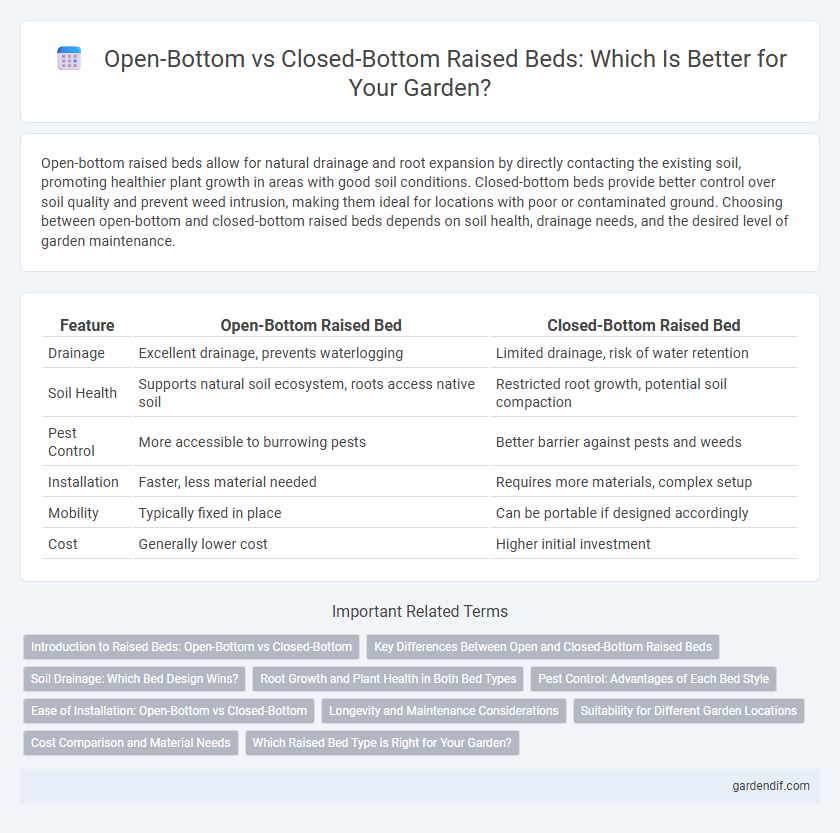
Open-bottom vs Closed-bottom beds Illustration
Open-bottom raised beds allow for natural drainage and root expansion by directly contacting the existing soil, promoting healthier plant growth in areas with good soil conditions. Closed-bottom beds provide better control over soil quality and prevent weed intrusion, making them ideal for locations with poor or contaminated ground. Choosing between open-bottom and closed-bottom raised beds depends on soil health, drainage needs, and the desired level of garden maintenance.
Table of Comparison
| Feature | Open-Bottom Raised Bed | Closed-Bottom Raised Bed |
|---|---|---|
| Drainage | Excellent drainage, prevents waterlogging | Limited drainage, risk of water retention |
| Soil Health | Supports natural soil ecosystem, roots access native soil | Restricted root growth, potential soil compaction |
| Pest Control | More accessible to burrowing pests | Better barrier against pests and weeds |
| Installation | Faster, less material needed | Requires more materials, complex setup |
| Mobility | Typically fixed in place | Can be portable if designed accordingly |
| Cost | Generally lower cost | Higher initial investment |
Introduction to Raised Beds: Open-Bottom vs Closed-Bottom
Open-bottom raised beds allow roots to grow directly into the native soil, improving drainage and promoting natural soil ecosystem interaction. Closed-bottom beds provide complete control over the soil environment, preventing weed intrusion and enabling precise soil composition management. Choosing between these bed types depends on factors like soil quality, drainage needs, and root depth requirements.
Key Differences Between Open and Closed-Bottom Raised Beds
Open-bottom raised beds allow direct root access to native soil, promoting natural drainage and beneficial soil organisms' interaction, ideal for improving soil structure over time. Closed-bottom raised beds contain a solid base, preventing erosion and weed infiltration, suitable for areas with poor or contaminated soil. The choice depends on drainage needs, soil quality, and desired control over root growth and soil composition.
Soil Drainage: Which Bed Design Wins?
Open-bottom raised beds provide superior soil drainage by allowing excess water to flow directly into the ground, preventing waterlogging and root rot. Closed-bottom beds often require added drainage solutions, such as gravel layers or drainage holes, to avoid water accumulation. Optimal soil drainage in open-bottom designs promotes healthier root systems and improves plant growth.
Root Growth and Plant Health in Both Bed Types
Open-bottom raised beds promote deeper root growth by allowing roots to penetrate into the native soil, enhancing nutrient and water access vital for plant health. Closed-bottom beds restrict root expansion within the contained soil, which may limit root development but can offer better control over soil quality and reduce weed intrusion. Both types impact plant health differently, with open-bottom beds favoring natural root systems while closed-bottom beds support consistent soil conditions for sensitive plants.
Pest Control: Advantages of Each Bed Style
Open-bottom raised beds facilitate natural pest control by allowing beneficial organisms like earthworms and predatory insects to access the soil, enhancing biological pest suppression. Closed-bottom beds can be lined to prevent burrowing pests such as gophers and moles from invading the planting area, providing a physical barrier that limits underground pest damage. Choosing between open or closed-bottom raised beds depends on the specific pest challenges in your garden and desired level of protection against soil-dwelling pests.
Ease of Installation: Open-Bottom vs Closed-Bottom
Open-bottom raised beds offer greater ease of installation by allowing direct root access to the natural soil, eliminating the need for base preparation or drainage considerations. Closed-bottom beds require a solid foundation and careful attention to drainage to prevent waterlogging, which can lengthen setup time. Choosing open-bottom designs reduces labor and materials, making them ideal for gardeners seeking a quick and efficient installation process.
Longevity and Maintenance Considerations
Open-bottom raised beds promote natural soil drainage and encourage earthworm activity, enhancing soil health and reducing waterlogging risks for longer bed usability. Closed-bottom beds require more careful water management to prevent stagnation but protect underlying surfaces and contain soil amendments effectively. Maintenance for open-bottom beds may involve occasional weed control from surrounding soil, whereas closed-bottom beds typically need monitoring for drainage issues and periodic soil replacement.
Suitability for Different Garden Locations
Open-bottom raised beds are ideal for garden locations with well-draining soil as they allow roots to penetrate deeper and promote natural water drainage. Closed-bottom beds suit areas with poor or contaminated soil, preventing unwanted growth and allowing gardeners to control soil composition fully. Selecting the appropriate base type significantly impacts plant health, root development, and overall garden success in varied environmental conditions.
Cost Comparison and Material Needs
Open-bottom raised beds generally incur lower initial costs due to reduced material requirements, using fewer boards or panels since no base is needed, allowing for natural soil integration and drainage. Closed-bottom beds require more materials like plywood or heavy plastic to form a solid base, increasing expenses but offering better soil control and preventing weed growth. Choosing between the two depends on budget constraints and garden soil conditions, with open-bottom beds being more cost-effective and closed-bottom beds demanding higher upfront investment.
Which Raised Bed Type is Right for Your Garden?
Open-bottom raised beds provide improved soil drainage and encourage deep root growth by allowing plant roots to access native soil, making them ideal for gardeners with healthy underlying soil. Closed-bottom raised beds offer better control over soil quality and prevent weed intrusion, suitable for locations with poor or contaminated ground. Choosing the right raised bed type depends on your garden's soil condition, drainage needs, and whether you want to integrate natural soil beneath or rely entirely on imported soil mixes.
Open-bottom vs Closed-bottom beds Infographic

 gardendif.com
gardendif.com